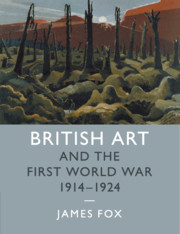Book contents
- Frontmatter
- Contents
- List of plates
- List of figures
- Acknowledgements
- Introduction
- 1 The outbreak of war and the business of art
- 2 Perceptions of art
- 3 The arts mobilize
- 4 War pictures: truth, fiction, function
- 5 Peace pictures: escapism, consolation, catharsis
- 6 Art and society after the war
- Conclusion
- Notes
- Bibliography
- Index
- Index
Introduction
Published online by Cambridge University Press: 05 August 2015
- Frontmatter
- Contents
- List of plates
- List of figures
- Acknowledgements
- Introduction
- 1 The outbreak of war and the business of art
- 2 Perceptions of art
- 3 The arts mobilize
- 4 War pictures: truth, fiction, function
- 5 Peace pictures: escapism, consolation, catharsis
- 6 Art and society after the war
- Conclusion
- Notes
- Bibliography
- Index
- Index
Summary
Introduction
On 4 August 1914 large crowds gathered in London's principal public spaces to celebrate – or in some cases denounce – the imminent outbreak of the European war. In Trafalgar Square the maffickers’ chants were so loud that according to at least one eye-witness they were still echoing some twenty minutes after they had been sung.1 Trafalgar Square was certainly an appropriate venue for such martial proceedings: conceived to commemorate Britain's victory in the Napoleonic wars a century earlier, it was arguably the nation's most belligerent political arena. The space, after all, was populated by military statuary, and surrounded by buildings that proclaimed the country's imperial might. One of those buildings, however, was the National Gallery. Devoted to beauty, peace and a common European spirit as expressed through the continent's art, the institution had for decades occupied an uneasy relationship with its bellicose surroundings. But as the war crowds ambushed its steps and transformed them into makeshift grandstands for their demonstrations, the future of that relationship seemed unusually uncertain.
For the many commentators who spent the late summer of 1914 speculating on art's likely place in the society that was about to be forged on the anvil of war, the scenes in Trafalgar Square might have suggested a number of possibilities. Pessimists might have seen the crowd's submersion of the National Gallery as a worrying sign that the delicate world of art was going to be crushed by waves of philistine ‘war fury’. Optimists, on the other hand, may well have interpreted the public's decision to gather there, on the steps of a museum, as heralding a new alliance between art and society – a return of the long-estranged cultural domain into the heart of heroic human affairs. But there were others who surely noticed that in the face of those marauding crowds, indeed throughout the momentous events of early August, the National Gallery's doors had remained locked. The realists among them might have concluded that despite superficial appearances, artistic life and public life would remain as obstinately discrete as they had been before the war.
Before 1914 art had indeed played a relatively minor role in British public life.
- Type
- Chapter
- Information
- British Art and the First World War, 1914–1924 , pp. 1 - 10Publisher: Cambridge University PressPrint publication year: 2015



